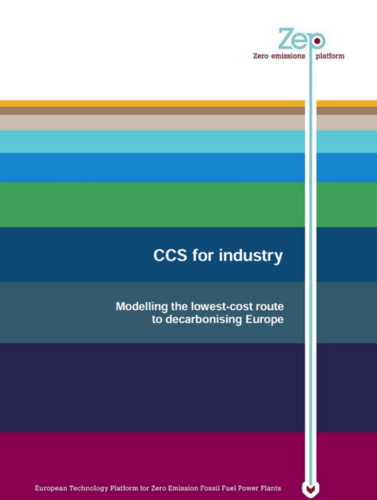CCS for industry: Modelling the lowest-cost route to decarbonising Europe
About the report
ZEP modelled the lowest-cost route to decarbonising Europe by looking at CCS for industries as refining, steel and cement.
After modelling the lowest-cost route for decarbonising European power, ZEP turned its attention to industry. With direct industry-related emissions accounting for a quarter of total EU CO2 emissions, it is clear that Europe must look beyond the power sector to include core industries such as refining, steel and cement.
Not only is CCS the only option for substantially reducing CO2 emissions in these industries, but the costs of CO2 transport and storage – 10-30% of the total CCS costs – can be significantly reduced by clustering power and industrial emitters.
Key conclusions
- Energy-intensive industries account for a quarter of EU CO2 emissions and cannot reduce them substantially without CO2 Capture and Storage (CCS).
- The absence of CCS support measures in the model (upfront public investment in CO2 transport and storage + incentives for energy-intensive industries) not only delays CCS deployment to 2040, but leads to a CO2 reduction of only 68% by 2050 – well below EU targets of 80-95% for power and industry.
- Investment in CO2 transport and storage infrastructure must start now to deploy CCS widely from
- 2025 – a delay of even 10 years will cost power and industry an extra €200 billion to reach these EU
- targets. It will also result in a forced doubling of the annual CCS deployment rate to 15-20 GW for power alone, which is unrealistic given supply constraints for the delivery of power plants, CCS infrastructure, and the necessary skills. Hence, delaying CCS deployment until 2035, while possible to model, risks severely limiting its optionality.
- When CCS is not part of the portfolio, the cost of reaching the EU’s CO2 reduction target for power increases by at least €1-1.2 trillion. The EU’s target for industry, on the other hand, is not achievable in any scenario.
2015 to 2025 is therefore a critical time for CCS deployment, for which support measures are
urgently required:
- Incentives for energy-intensive industries
- The Innovation Fund presents a once-in-a-decade opportunity to support both power and energy-intensive industries in developing and implementing full-chain CCS projects. It should build on the experience and learning of the NER300, accommodate a wide range of industrial sectors, and support projects across different scales.
- Member State policies, such as feed-in premia or contracts for difference (CfD), will play a key role in providing early investors with security of income.
- Upfront public investment in transport and storage infrastructure
- As clusters of power and industrial emitters will significantly reduce the costs of CCS, €6-12 billion investment is needed in 3-6 clusters, each with 20 MtCO2/year capacity, in order to kick-start deployment. This means creating fit-for-purpose funding for CCS infrastructure development – for example, through the proposed Innovation and Energy Modernisation Funds, regional and structural funds, Horizon 2020, and the Connecting Europe Facility (CEF).
- The modelling assumes that the long-term driver for CO2 reduction is an increasing CO2 price under the EU ETS (or similar). However, investments in CCS replace a variable CO2 price with long-term financial liability, which requires dependable boundary conditions. If the costs to reduce CO2 surpass the capacity of industry sectors to pay, a premium or CfD may still be required to drive the change.
- When CCS is deployed, the value of electricity storage in reducing decarbonisation costs is limited. However, in the longer term, electricity storage mechanisms will potentially play an important role in reducing the total cost of CO2 reduction for power grids with high renewable penetration when CCS is not available.
- Large geological formations identified in Europe have more than sufficient CO2 storage capability – ~80 GtCO2 – mainly deep saline aquifers. This is consistent with the model’s assumption of a 500 km offshore pipeline with offshore storage in a deep saline aquifer.
- Europe’s power sector will continue to feature a variety of technologies and fuels in which CCS will be both competitive and needed. Indeed, decarbonised coal and gas are essential to integrate solar and wind cost-effectively into the grid – for affordable, reliable, near-zero-CO2 power.
- Following the original publication of this report and at the request of the Advisory Council, some additional sensitivity studies were conducted to assess the impact of lower fixed Operation and Maintenance costs for the Solar PV technology. The O&M cost of Solar PV in 2050 was reduced from 26 €/kW/a to 19.5 €/kW/a and 13 €/kW/a as two sensitivities (see also Figures 27 and 28). The effect is to shift the optimisation to build more PV and less of other technologies. The change does not affect the principle conclusion of the report that adding CCS to the mix leads to the lowest cost option to achieve the emissions targets by 2050. Not having CCS available will increase the cumulative costs by 1-1.2 trillion Euro, depending on the assumed O&M costs for Solar PV. These sensitivities demonstrate that the importance of a mix of technologies, including CCS on Industrial and Power emitters, is robust to variations in the assumptions. We remind the reader that the cost assumption for the capex of PV in the low PV cost case used in this report includes a 5-fold reduction in the cost of PV from today’s cost out to 2050, a very aggressive assumption.
